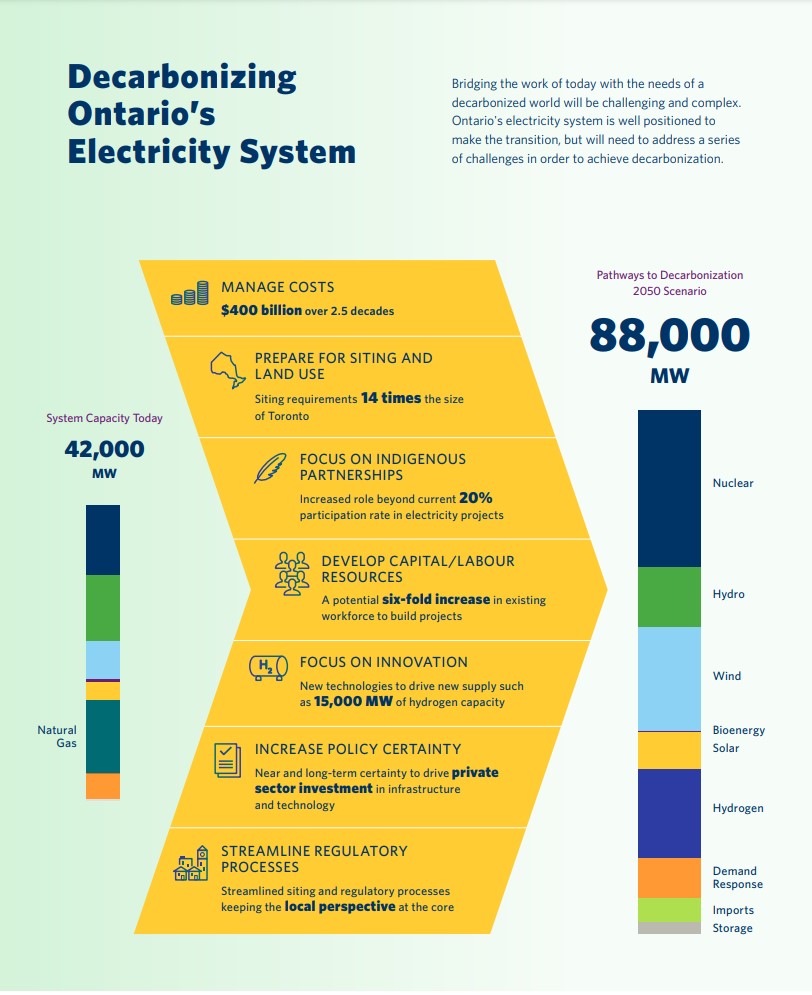IESO Releases Pathways to Decarbonization Report
In a Pathways to Decarbonization report released by the Independent Electricity System Operator (IESO) on December 15, 2022, at the request of Ontario’s Minister of Energy, the IESO found that a moratorium on new gas generation could commence as early as 2027, and a pathway to decarbonization could be achieved by 2050.
The report focused on two scenarios: moratoriums and pathways. These scenarios analyze and identify potential opportunities and challenges to consider as the province moves towards decarbonization. A key message is that while decarbonization and limits on gas generation are achievable, the costs (and impacts to Ontarians) will be substantial. The decarbonization scenario forecasts costs for infrastructure and supply of around $400 billion, with annual system costs of $60 billion.
Some of the challenges (and solutions to those challenges) identified by the IESO in the two scenarios are highlighted in the following illustration taken from the report:

Moratorium on New Natural Gas Generation Facilities
The IESO’s assessment indicated that a moratorium on new natural gas facilities would be feasible beginning in 2027. At that point, the system would not require additional emitting generation to ensure reliability, provided that non-emitting supply can be added to the system and keep pace with demand growth. Existing natural gas generation facilities would continue to be used, and would be available for recontracting in some cases. The results of this scenario would require investments of approximately $26 billion in new infrastructure.
Pathway to Decarbonization
In the development of a pathway to a decarbonized grid, the IESO adopted a more aggressive electrification demand forecast. The pathways scenario illustrates a system designed to meet winter peaks that are almost three times higher than those Ontario experiences today.
The report anticipates a decarbonized supply mix by 2050 with contributions from new nuclear, conservation, demand response, renewables and storage. The report also identified a need for a significant increase in transmission capability.
Overall, the report also found a system more than double today’s size would be required to attain a decarbonized electricity sector by 2050, costing around $400 billion. One key insight of the analysis is that phasing gas generation out of the system will require ingenuity and new technologies. Simply put, there exists no like-for-like replacement for natural gas currently, and Ontario’s natural gas generation is capable of providing continuous, flexible energy year-round and in all weather conditions. Natural gas will continue to be used until reliable replacements are identified and implemented into service.
Risks of Decarbonization
Developing a decarbonized grid comes with risks. Risks identified by the IESO include:
- Large infrastructure such as hydroelectric, nuclear facilities and transmission can take 10 to 15 years to build.
- Significant investments in capital, materials and labour will be required to build out a fully decarbonized system. The labour force currently working on electricity infrastructure projects may need to increase from 14,000 to 84,000.
- Meaningful and transparent discussions with First Nations and communities about siting and land use will be required.
- Ontario and Canada will need to continue to invest in new technologies, such as hydrogen and other innovations.
- Energy plans need to be approved and new infrastructure needs to be planned, permitted and sited.
- Costs must be carefully managed to ensure the actual impact on total energy costs is affordable and that they do not diverge significantly from those of our neighbours.
The IESO also identified several “no-regret” actions that it can take to help meet growing demand, including: accelerating efforts to acquire non-emitting supply; expanding energy-efficiency programming; beginning planning and siting work for nuclear, storage, hydro and transmission projects which require long lead times to develop; galvanizing collaboration amongst stakeholders; and continuing support for low-carbon fuels such as hydrogen.
